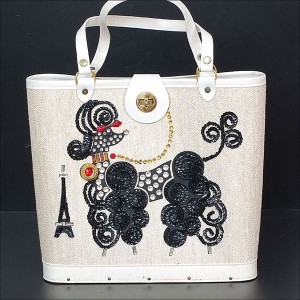From the “Real Housewives” and the ladies that walk the red carpet, to the actual housewives who clean the carpets, there is one common thread that ties all us gals together . . . we love our handbags!
Whether it’s Grandma’s delicately beaded 1920s evening bag, or one of the kitschy fringed shoulder bags from the 70s, vintage handbags reflect our taste, personality and our mood on any given day. Discouraged by the high prices at the trendy boutiques? This is an area of collecting where you can still hit the jackpot at flea markets and estate sales if you know what to watch for.
The romanticism of the 1920s is reflected in the metal mesh bags created by Whiting Davis and the Flapper style bags by Alfred Dunhill. Silks, beads, and semi-precious stones are typical characteristics of bags from this era, many of which were quite diminutive in size. The “Pochette,” a flat rectangular purse carried under the arm, surfaced as the leading style of the era. Collectors also watch for hand-tooled leather “box” purses and bags with Egyptian motifs inspired by the discovery of King Tut’s Tomb in 1923.
Simplicity is the key word for bags from the 1930s. The Art Deco movement of this era highly influenced the handbag industry with a wide variety of new shapes and sizes being introduced. Gone were the elaborate stylings of the 20s and in their place women carried envelope clutch purses, simple shoulder bags and the classic, clasp-framed handbag. Fabrics to watch for include ostrich, crocodile and snake skin.
The war years of the 1940s brought great changes to the companies producing handbags. Materials such as leather, metal closures, and zippers were needed to support the country’s military efforts, forcing designers to use wood, plastics and other synthetic materials. Bark cloth bags with wooden handles and shiny Lucite shoulder bags were popular. As we progress through this decade we also see the return to bright colors, a trend that would continue into the 50s.
With the 1950s came an economic resurgence in the U.S. and handbag sales soared. The light natured mood of the era was reflected in novelty bags from Wilardy, Rialto and Llewellyn, featuring sequined poodles, musical notes and Las Vegas dice. Brushed aluminum, clear vinyl, gold lamé and faux leopard skin print were just a few of the unusual materials in this “anything goes” period of handbag design.
In the early 1960s we were introduced to the “Hippie Boho” look. Large casual bags of cloth, suede, pony fur, macramé and leather and trimmed with fringe and beads are especially popular with collectors. Towards the more formal side were bags of alligator and bejeweled examples with large elaborate clasps. Designers of note include Mary Quant, Gucci and Coach who made their now-classic, brown leather handbag shaped like a gym bag.
The across-the-body shoulder strap purse resurfaced early in the 1970s and remained a staple throughout the decade. Color was the key word for designer bags with turquoise, pink and various shades of green heavily used. Leading designers of the day included, Etienne Aigner, Lou Taylor Brown, Dior and the new kid on the block, Louis Vuitton, who’s “LV” logo bags are a must for any vintage 1970s collection.
When shopping for vintage bags here are 6 questions to consider to establish authenticity: Is the stitching tight and even? Is the appropriate designer label present inside and out? If it is leather, does it smell like leather? Is the proper logo present and is it spelled correctly? Is there a serial number on the inside? and Is the color even throughout the bag? If the answer is no to any of these questions, then you may be looking at a fake. Until next time……..Linda
Linda Kennett is a professional liquidator specializing in down-sizing for senior and the liquidation of estates and may be reached at 317-258-7835 or lkennett@indy.rr.com



